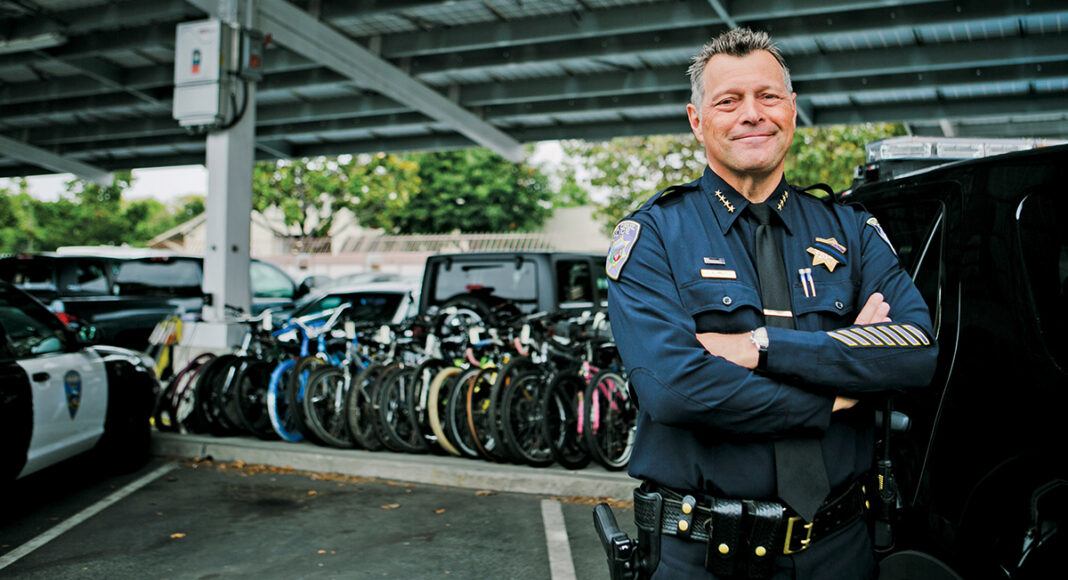From the top-floor briefing room of the Santa Cruz Police Department (SCPD), windows look out over rooftops throughout downtown. It’s one of five regions that city cops have staked out for the new neighborhood policing strategy announced by Chief Andy Mills a few months ago.
“We’re not going to sit back and wait for crime to come to us. We’re going to go to it,” Mills says.
Mills is standing in front of a large map that has Santa Cruz split into color-coded areas—the Upper Westside, Lower Westside, Downtown, Upper Eastside and Lower Eastside. In some ways, the operation sounds more like a department store staffing than a police operation, with Mills describing his lieutenants as “mid-level managers.” Each lieutenant gets assigned a number of police and community service officers. In a department with 94 cops total, 26 community service officers, lieutenants and sergeants have been reassigned without an increase in spending, Mills says. The SCPD is also still relying on its predictive policing algorithm to target higher-crime areas before new crimes happen.
“The theory behind neighborhood policing is to work with the neighbors to deal with long-term problems and reduce them,” Mills says, “because the problems in one area are different than in others.”
By focusing on specific sections of the city, lieutenants and their small teams of police and community service officers get to know the neighborhoods and community members better. The idea is that the groups can prioritize, respond to and prevent crime in their sections.
Although it was only implemented in February, it’s a plan Mills has worked on since becoming chief in July of last year. Over that time, the police department has held 10 community meetings to gather information and listen to residents’ concerns about what they think are ongoing problems in their areas.
The policy has two goals. The first is to prioritize each area’s crime so that officers can more efficiently respond if a top level threat occurs. “When you call 911, what do you expect?” Mills asks rhetorically. “Someone to respond immediately.”
That’s an approach often known as “no call too small.” However, according to a study by the Center for Public Safety Management—a nonprofit that assists local governments on how to better serve their citizens—that philosophy comes at a great cost.
The SCPD dispatches officers on roughly 68,000 of the estimated 100,000 yearly calls. But according to the study, 22,000 of the cases responded to could be handled by someone other than a police officer. The 911 emergency line is intended for a crime in progress, to save a life or stop imminent violence, but unintentional abuse of the hotline has dispatchers busy with barking dogs, loud music complaints and other activities that are not crimes, no matter how bothersome.
“About 77 percent are bottom-priority calls,” Mills says. He encourages residents to make such calls to the department’s non-emergency number, 471-1131.
The second goal is to keep arrests low by preventing common crimes in specific areas. Mills says he wants officers to make any necessary arrests, but also believes many problems in the community can’t be fixed through enforcement alone.
He gives the analogy of a hypothetical intersection with a high collision rate. Officers can zero in on that intersection, ticketing anyone who runs a red light. And the city can install traffic signs with violation fees and program a forced delay between light changes to clear the area. In the case of neighborhood policing, preventative and informative measures can be as simple as educating communities with high-volume break-ins to lock their windows when they’re not home.
Still, Mills says there are other methods “to fix these problems in the long haul” and that the department has many tools at its disposal. “SCPD is not here to make excuses for why crime exists,” Mills says. “We’re trying to figure out how to proactively control it.”
The department has integrated this neighborhood-oriented strategy into predictive policing, a tool the department has been using for more than six years. Local company PredPol helped lead something of policing revolution when it launched in 2012, helping departments like Santa Cruz target higher-crime areas at higher-crime times. PredPol is now in more than 50 departments, according to co-founder Dr. Jeff Brantingham, who is also an anthropology professor at UCLA.
These days, neighborhood lieutenants receive a report every morning to see which areas on their beat should be more heavily patrolled, based on previously reported crimes. It also serves as a gauge that will show whether or not previously problematic spots are becoming safer through officers’ efforts. The managers then give Mills a weekly report of the locations and types of crime they’re working on, how they are doing it and their results.
Former SCPD crime analyst and current county supervisor Zach Friend says he’s seen predictive policing have a positive impact over the years.
“It was meant to complement the strong history and philosophy of community-oriented policing within the department,” says Friend, “and allow for the most effective allocation of very limited resources.”














Thanks for reporting on this Mat. I hope this will stick for the long run…